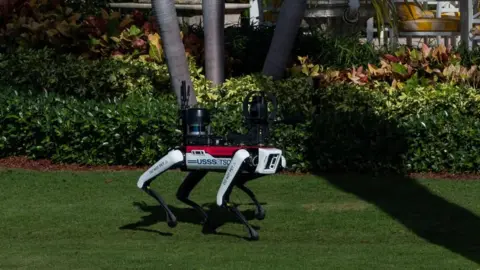 Reuters
ReutersA robotic dog named “Spot” made by Boston Dynamics is the latest tool in the arsenal of the US Secret Service.
The device has lately been spotted patrolling the perimeter of President-elect Donald Trump’s Mar-a-Lago resort in Palm Beach, Florida.
They do not have weapons – and each can be controlled remotely or automatically – as long as its route is pre-programmed.
Passers-by are warned by a sign on each of Spot’s legs: “DO NOT PET.”
“I don’t know that anyone is tempted to pet these robot dogs. They do not look cuddly,” said Melissa Michelson, a political scientist at Menlo College.
Video of Spot strutting around the property has gone viral on TikTok – where reactions range from calling them cool and cute, to creepy – and become fodder for jokes on American late night television. But its mission is no laughing matter.
“Safeguarding the president-elect is a top priority,” said Anthony Guglielmi, US Secret Service chief of communications, in a statement to the BBC.
In the months leading up to the US presidential election, Trump was the target of two apparent assassination attempts. The first took place at a July rally in Butler, Pennsylvania and the other occurred at the Mar-a-Lago golf course in September.
Citing “concern for operational security,” the Secret Service declined to answer the BBC’s specific questions about the use of robotic dogs in Trump’s security detail, including when the agency began deploying the device at his primary residence.
Boston Dynamics also declined to answer specific questions, although it confirmed the Secret Service was deploying its Spot robot.
So why might the Secret Service be using them now?
Ron Williams, a former Secret Service agent who is now CEO of the security and risk management firm Talon Companies, suspects the assassination attempts against Trump added urgency to the agency’s push “to upgrade the technology that can enhance the ability to detect and deter,” Williams said.
At Mar-a-Lago, where so much of the property is exposed, Williams said robotic dogs are long overdue. “They can cover a lot more area” than humans alone, Williams said of the dogs, which he expects will become more of a common sight over time.
And it’s not just the Secret Service. Williams said robotic dogs have increasingly become a tool used by militaries and law enforcement agencies around the world.
A bomb squad in Montgomery County, Pennsylvania that purchased Spot in the spring deploys the device to inspect potential explosives, according to Boston Dynamics promotional materials.
Last year, the New York Police Department moved forward with adding the robotic canines to its force despite complaints of “a dystopian overreach of police power,” according to Wired.
On the other side of the globe, Ukraine has used them to conduct reconnaissance in the ongoing conflict sparked by Russia’s invasion in 2022, the Kyiv Post reports.
See Spot run
Spot is known for its agility. It can walk up and down stairs and navigate tight spaces. It can even open doors.
But its ability to reveal potential threats ranks high among the reasons that so many agencies appear willing to pay up to $75,000 (£59,000) for the device.
Secret Service communications chief Guglielmi said the robotic dogs were “equipped with surveillance technology, and an array of advanced sensors that support our protective operations”.
The device comes outfitted with multiple cameras that generate a 3D map of its surroundings, according to Boston Dynamics marketing materials, and can also have extras such as thermal sensing.
But none of this happens without a human master.
“They basically have a joystick controlling the robot dog as it walks around,” said Missy Cummings, an engineering professor at George Mason University who runs the university’s Autonomy and Robotics Center. Spot can also move automatically along predefined routes.
Unlike their human and real canine counterparts, robotic dogs aren’t distracted by visuals, sounds or smells they encounter.
But despite their many impressive features, the devices can be taken down.
“You just have to spray it with Aqua Net hairspray in its ‘face’,” Cummings said. “And that would be enough to stop the cameras from working correctly.”
While the robotic dog seen at Mar-a-Lago is not armed, she says competitors appear to be experimenting with models that are.
“People are trying to weaponise these dogs,” Cummings adds, citing a Chinese model with an attached rifle which she learned about at a robotics meeting this week.
They aren’t about to replace humans, says Melissa Michelson, who likens the devices to assisted-driving technology in some vehicles.
“We don’t have a lot of faith in the ability of cars to drive by themselves,” Michelson said.
Secret Service agents at Mar-a-Lago have been seen patrolling alongside Spot.
“We still do need those humans behind the scenes to use human judgment and be able to jump in if there’s a technology breakdown,” she says.









